Barbie turns 65, but she’s not retiring: EL PAÍS spent a day in her domain, the Mattel offices where she was created
With more than one billion units sold worldwide — and even after the movie’s success last summer — the doll is farther away from retirement than ever. A walk through the California facilities where she is mass-produced and a conversation with the person in charge demonstrates that Barbie isn’t going away anytime soon


Barbie was born on March 9, 1959. And, by August of 1963 — according to the advertisements — she was already the most popular doll in town, at a cost of barely $3 (or $30 in today’s money, taking inflation into account).
In 1965, Barbie went to the moon. In the mid-1970s, she already owned a camper van, had practiced as a surgeon and was a participant in the Olympic Games. And, by the 1980s, she had been styled by Vidal Sasson, painted by Warhol, become Hispanic and Black, flown airplanes and appeared on MTV. In the 1990s, she was playing soccer and wearing Bob Mackie’s designs (after having already won the presidency several times). In the 2000s — with formal clothes from Versace and tracksuits from Juicy Couture — she did modelling shows and starred in more than 30 films. In the 2010s, she broke two million followers on social media, gained three different body types and dressed up as iconic designer Karl Lagerfeld.
In the present decade, Barbie — who has posed as Queen Elizabeth II and opened a TikTok account — has been diagnosed with vitiligo and Down syndrome. She’s also been in a wheelchair. And, this year, she turns 65. Welcome to retirement age.
So, does the meteoric career of the most famous doll in the world end here? Don’t count on it.
She still has a lot of personalities to assume, while her creators have imagined many more worlds for her. This is especially the case after the film Barbie (2023) has given her name a huge boost. In the offices where she was born and has grown up over the past 65 years, Barbie is still the queen.
Mattel’s offices are located in the small Californian city of El Segundo, located within Los Angeles County. It’s a quiet town with just 17,000 inhabitants. It gets its name from the Chevron refinery that was installed here back in 1911. A Boeing facility is currently the main employer in the municipality, while it also hosts the offices of the Los Angeles Lakers and the LA Times.
Beyond the tree-lined streets, from time to time, you pass an all-pink van with a huge Barbie design. “This way to Barbieland!” the text on the little bus announces, breaking up the line of trucks and Teslas that cross the streets. There are hardly any pedestrians.
The bus transports employees and visitors to the headquarters of Mattel, the doll’s parent company. No, it’s not the same headquarters (inside or out) that’s seen in the film. It’s much larger and somewhat less gray. There’s a tower similar to the one seen in Greta Gerwig’s film (although the one in the movie is actually the headquarters of a bank in the financial district of Los Angeles). There are also low-rise buildings where the design team works, creating the dolls and their universe.

Mattel has 32,000 employees around the world, but these offices are primarily home to the core management, administrative and design teams. This is where Barbies are thought up, where they are created, designed and sketched. Where dolls come to life. In the offices, they don’t usually allow visits, not even for the press. However, an exception has been made on the 65th anniversary of Barbie: a tour has been organized to allow journalists (from only about a dozen media outlets) and some influencers from around the world to learn about the operations. EL PAÍS has been included in this group.
The route — in which there are Barbies everywhere, even in the bathrooms — is guided by the company’s workers. There are areas with signs that read “Top Secret” or “No Entry Allowed,” but in general, access and questions are permitted.
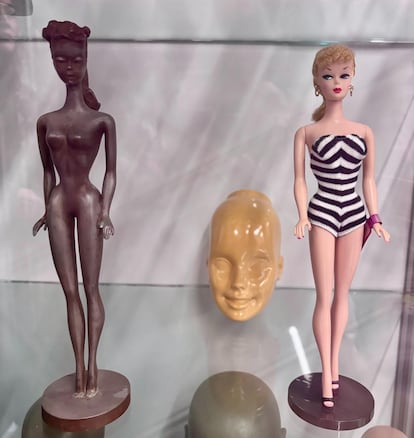
As the teams note, the work here is very specialized. The majority of the employees are experts who create first versions of the doll in 3D: they make up their faces by hand, decide what kind of hair should be used, or sew the outfits with the use of traditional machines. There are even experts who make the boxes where the dolls will be placed, presented and sold. Of course, this doesn’t mean that everyone can contribute towards the birth of a new Barbie, whether it’s an adaptation of an already-existing model with small variations, or a total revolution.
One of the biggest revolutions that took place in the Barbie enterprise had to do with something that was subject to criticism for decades: the fact that Barbie, throughout a large part of her existence, was blonde and had impossible measurements. Her skin and hair color became varied in the 20th century, but it was only in 2016 when the company incorporated three more realistic body types, resulting in a taller doll, a shorter one and a heavier one (or, perhaps, one that was simply less thin). Even Time magazine featured this change on its cover under the ironic headline: “Now can we stop talking about my body?”
One of the architects of this change was Kim Culmone, vice-president and head of doll design for more than a decade: “Barbie is, today, the most diverse doll in the world,” she states with complete confidence. “When you look around the world, look at all the different types of people. There’s no lack of inspiration. On the market, you continue to introduce dolls that haven’t existed in the [product] line before, or perhaps even in the world before…. but the reason you do it is because, when a kid can see themselves reflected in a toy line, it validates them.”
The design team is made up of just 15 people, who usually start the ideas off. Then, they join each creative leg of the operation — including hairdressing, clothing, the social media team, etc. — to bring the dolls to life. This process is headed up by Culmone. And that’s why for her — like for so many others — when they announced three new Barbie body types in January of 2016, it was a turning point in the company, just as it was when the film arrived in the summer of 2023.

After that, other changes came about, including a greater variety of races, bodies, hairstyles, or physical features, some of which were meant to have been caused by a certain illness or accident. This variety is also seen in the tour of the Mattel offices. The originals — including the bronze sculpture of one of the first dolls — remain locked in display cases. Before, they were made out of clay, but now, technology has made everything easier… or more complicated, because managing the 3D panel isn’t easy.
Sculptor Kittaya Wongchinda misses the days of clay. Still, she recognizes that this digital system helps her be more agile. For instance, it has allowed her to create new faces, like that of a recent Claudia Schiffer Barbie.

Sasha Stoyan Lopez is in charge of painting the dolls’ faces. She decides what the eyebrows and eyelashes are like (the doll has had them since 1970), or how much Barbie smiles. Equipped with special glasses, Lopez is able to sketch a complete face on that little plastic ball (Barbie’s head) in just five minutes. Although, she concedes with a smile, it usually takes her much longer.
After the designs are complete, each Barbie of the millions of units sold (Mattel doesn’t provide specific data) is assembled in different factories around the world. But there’s one step that’s done in El Segundo: putting the hair on each and every one of the dolls. There’s a small room with lots of spools of colored threads — mostly yellow and brown, but also pink, green or purple — of different thicknesses: that’s Barbie’s hair. These threads are manipulated — by hand and by machine — until the desired shape, thickness and hairstyle that the design team is looking for is achieved.
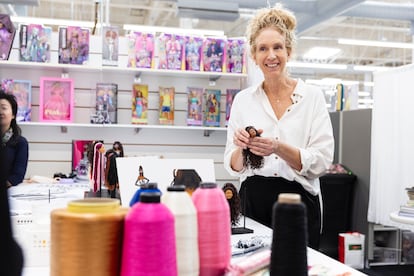
It’s also striking to see how much thought is put into designing something that the customer doesn’t usually think about: boxes. Suzanna Lakatos is the packaging design director and the person who thinks about the doll’s posture, the shape of the box that it’s displayed in, as well as the colors and photographs used. For the Barbie created for the 65th anniversary, she devised more than 20 boxes with different backgrounds (Barbie pink was selected over the sapphire blue typical of 65th anniversaries), tones, graphic designs, phrases and doll postures. Esthetics are very important, but she goes even further:
“There’s a physical component: the pose. And the main challenge is [for the doll] not to fall. There are limits,” Lakatos laughs. She knows that her work is especially valued by collectors, who appreciate the packaging and never take their doll out of it, because if they do, it loses value.
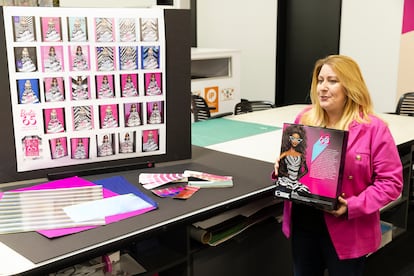
“We — as a collective team — [are always] asking, ‘how can we do more? How can we be better? How can we leave this brand better than we found it?’ I asked my team: ‘If you could do anything you wanted to do with Barbie, no rules, what would you do?’” Culmone recalls. For her, the challenge is for Mattel to remain relevant and keep leading the market. “Most toys last three to five years… and you have to be very successful to go from being three to five-years-old to being 65. As a brand, the only way to do that is to constantly evolve, to make sure that you’re resonating and that you’re connecting to today’s generation of children and parents and fans. We were seeing that we didn’t have the resonance of the past and we had to change.”
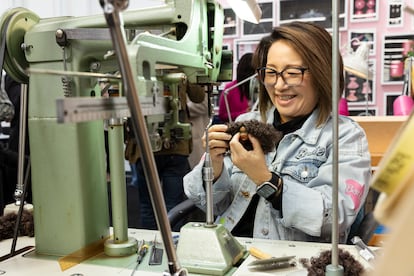
Lisa McKnight — Mattel’s executive vice-president — agrees with that need for connection that Culmone talks about. “The average toy cycle is five years... and the fact is that we’ve surpassed three generations. It’s incredible to have come this far, [to have achieved] this timelessness. And our purpose is to place this woman (Barbie) in a position of power and for her to be representative of the world,” she says. “And we’re more conscious than ever that everyone is welcome.”

That welcome that McKnight conveys to everyone seems more and more real in recent years, as Barbie has become a global phenomenon thanks — above all — to social media. In addition to a classic profile on Instagram (3.5 million followers) and TikTok (two million), Mattel has had the BarbieStyle Instagram (2.8 million) up and running for 10 years, where they play with Barbie, place her in different scenarios, take her to the Grammys, or make her live moments from ordinary life. Everything is as fake as the doll itself, obviously… but everything is as authentic as it can be.
In Mattel’s offices, all of this content is photographed and recorded. On the day of the press tour, for instance, the crew members are messing around on a set that contains a huge house for Barbie (one that’s about four or five times bigger than the doll house available in toy stores) to film her baking a birthday cake. There’s a mixer, a carton of milk, strawberries and even Barbie-sized eggs.
Zlatan Kusnoor — the creative responsible for the toy’s social media accounts — explains that everything is so real that, if Barbie travels to Canada, the team takes her to Canada with a suitcase full of clothes and accessories. “We would never fake it. [It’s all] uberauthentic. We’ve been collecting beautiful props for 10 years, we custom-make them.”

To prepare all her looks, Barbie has a stylist: Rachel Ritter. Her work office — which has a board covered in clippings — is every Barbie fan’s dream. She has closets and drawers full of objects, including sandals, belts, fur coats and party dresses. She has access to wardrobes from the archives (such as the clothes that the doll wore to the Grammys), but also to what the design team creates on a day-to-day basis, as well as pieces that are custom-made after being inspired by fashion magazines, social media trends and catwalks. “You can still enjoy Barbie as an adult,” Ritter smiles.
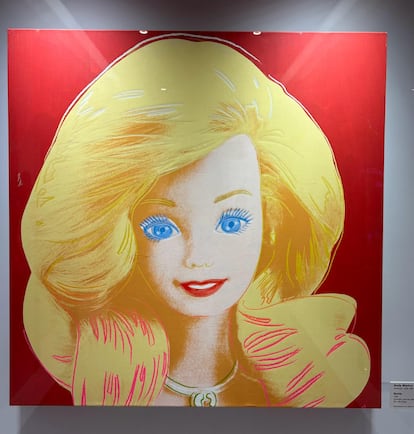
“The more diverse the dolls are, the richer the storytelling,” Culmone affirms. “And that can happen in film, or it can happen on the floor when kids are playing with their Barbies. So that’s why it’s so important to diversify your collection of dolls, because then the storytelling gets even more dynamic, real and rich.”
That is to say, appearing on TikTok and walking on the red carpet shows that — at 65-years-old — Barbie is far from retiring, even if she could. With more than 1 billion dolls sold to-date, she even has an original Andy Warhol with her face in the hallway next to the elevator. The time hasn’t come for her to say goodbye: she still has many hours of play ahead of her.
Sign up for our weekly newsletter to get more English-language news coverage from EL PAÍS USA Edition
Tu suscripción se está usando en otro dispositivo
¿Quieres añadir otro usuario a tu suscripción?
Si continúas leyendo en este dispositivo, no se podrá leer en el otro.
FlechaTu suscripción se está usando en otro dispositivo y solo puedes acceder a EL PAÍS desde un dispositivo a la vez.
Si quieres compartir tu cuenta, cambia tu suscripción a la modalidad Premium, así podrás añadir otro usuario. Cada uno accederá con su propia cuenta de email, lo que os permitirá personalizar vuestra experiencia en EL PAÍS.
¿Tienes una suscripción de empresa? Accede aquí para contratar más cuentas.
En el caso de no saber quién está usando tu cuenta, te recomendamos cambiar tu contraseña aquí.
Si decides continuar compartiendo tu cuenta, este mensaje se mostrará en tu dispositivo y en el de la otra persona que está usando tu cuenta de forma indefinida, afectando a tu experiencia de lectura. Puedes consultar aquí los términos y condiciones de la suscripción digital.
More information
Archived In
Últimas noticias
Petro claims the ELN was the target of US attack in Venezuela
Maduro counterattacks Trump with rhetoric and announces downing of nine drug trafficking aircraft
‘Ecce Homo’: The miraculous disaster that made a small Spanish town famous
Return to sex testing at the Olympics: IOC edges closer to banning transgender women
Most viewed
- Sinaloa Cartel war is taking its toll on Los Chapitos
- Oona Chaplin: ‘I told James Cameron that I was living in a treehouse and starting a permaculture project with a friend’
- Reinhard Genzel, Nobel laureate in physics: ‘One-minute videos will never give you the truth’
- Why the price of coffee has skyrocketed: from Brazilian plantations to specialty coffee houses
- Silver prices are going crazy: This is what’s fueling the rally









































